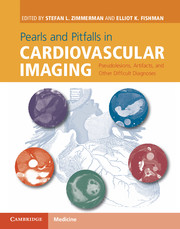 Pearls and Pitfalls in Cardiovascular Imaging
Pearls and Pitfalls in Cardiovascular Imaging from Section 7 - Acute aorta and aortic aneurysms
Published online by Cambridge University Press: 05 June 2015
Imaging description
In some patients, fluid in the anterior portion of the superior aortic recess of the pericardium can extend cranially and abut the aortic arch and the arch branch vessel origins. In patients being evaluated for trauma with multidetector CT, this fluid may be mistaken for periaortic hematoma (Figure 58.1). However, unlike hemorrhage, fluid in a pericardial recess will measure simple fluid attenuation and will have sharp, well-defined borders. Pericardial fluid abuts the aorta and great vessels without an intervening fat plane. Patients with acute aortic injury and hematoma will have high-attenuation fluid next to the aorta and a contour abnormality or intimal flap within the aorta itself.
Importance
Misdiagnosis of traumatic aortic injury could lead to inappropriate invasive catheter angiography or surgery.
Typical clinical scenario
Fluid in the superior aortic recess is common and may be encountered in patients with or without an associated pericardial effusion.
Differential diagnosis
In the setting of trauma, fluid in the superior pericardial recess can mimic periaortic hemorrhage; however, these entities can usually be distinguished by attenuation measurements (Figure 58.2). Fluid collections in the superior aortic recess simulating lymphadenopathy or aortic dissection have also been described.
Teaching point
Fluid in the anterior portion of the superior aortic recess abutting the aortic arch can mimic periaortic hematoma. Measurement of fluid attenuation values and close inspection of the aorta for contour abnormalities or intimal injury will help avoid misdiagnosis.
To save this book to your Kindle, first ensure no-reply@cambridge.org is added to your Approved Personal Document E-mail List under your Personal Document Settings on the Manage Your Content and Devices page of your Amazon account. Then enter the ‘name’ part of your Kindle email address below. Find out more about saving to your Kindle.
Note you can select to save to either the @free.kindle.com or @kindle.com variations. ‘@free.kindle.com’ emails are free but can only be saved to your device when it is connected to wi-fi. ‘@kindle.com’ emails can be delivered even when you are not connected to wi-fi, but note that service fees apply.
Find out more about the Kindle Personal Document Service.
To save content items to your account, please confirm that you agree to abide by our usage policies. If this is the first time you use this feature, you will be asked to authorise Cambridge Core to connect with your account. Find out more about saving content to Dropbox.
To save content items to your account, please confirm that you agree to abide by our usage policies. If this is the first time you use this feature, you will be asked to authorise Cambridge Core to connect with your account. Find out more about saving content to Google Drive.